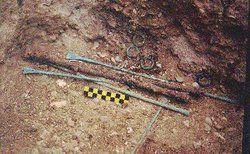Excavations at Stanway, Colchester (
Camulodunum) U.K. which date at latest, to just before the Romans arrived in England have provided a very exciting glimpse back into the Celtic past. The site is unique because of the finds in the grave of an individual dubbed
the doctor who was buried with...

- Mysterious rods and rings
...an array of instruments which are easily identifiable as those used by modern surgeons. They are different enough from typical Roman medical 'kits' that have been found elsewhere, and appear to be Celtic (Briton) variations. The doctor was probably a healer, one of the Druid class. He was buried with other interesting items, including feast-ware and a
gaming board of a kind heretofore unknown with white and blue glass pieces laid out 'in play'. One of the most intriguing finds may have served some kind of function for divination.
Eight rods four made of iron (in two slightly different sizes) and four of copper (also in two sizes) seem to be arranged as if laid in a long narrow box. These were found in proximity to
eight rings whose arrangement seem to indicate that they were once connected to a now disintegrated wooden box via cloth or leather loops in some way (perhaps to hold on a flap cover?). The druid/healer/doctor might have used the rods to determine if a certain course of action was likely to be good or ill-omened.
Excavations at Stanway, Colchester ([url=http://www.catuk.org/excavations/stanway/index.html]Camulodunum[/url]) U.K. which date at latest, to just before the Romans arrived in England have provided a very exciting glimpse back into the Celtic past. The site is unique because of the finds in the grave of an individual dubbed [url=http://www.catuk.org/excavations/stanway/doctor.html]the doctor[/url] who was buried with...
[attachment=0]rods_insitu.jpg[/attachment]
...an array of instruments which are easily identifiable as those used by modern surgeons. They are different enough from typical Roman medical 'kits' that have been found elsewhere, and appear to be Celtic (Briton) variations. The doctor was probably a healer, one of the Druid class. He was buried with other interesting items, including feast-ware and a [url=http://www.catuk.org/excavations/stanway/gaming_board_as_found.html]gaming board[/url] of a kind heretofore unknown with white and blue glass pieces laid out 'in play'. One of the most intriguing finds may have served some kind of function for divination. [url=http://www.catuk.org/excavations/stanway/rods.html]Eight rods[/url] four made of iron (in two slightly different sizes) and four of copper (also in two sizes) seem to be arranged as if laid in a long narrow box. These were found in proximity to [url=http://www.catuk.org/excavations/stanway/rings.html]eight rings[/url] whose arrangement seem to indicate that they were once connected to a now disintegrated wooden box via cloth or leather loops in some way (perhaps to hold on a flap cover?). The druid/healer/doctor might have used the rods to determine if a certain course of action was likely to be good or ill-omened.